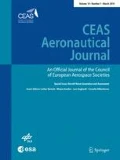1 Correction to: CEAS Aeronautical Journal https://doi.org/10.1007/s13272-021-00508-8
Unfortunately, errors were mistakenly included in the article during publication, relating to a partially misleading presentation of numbers and equations as well as missing sentence parts and citations in the text. Therefore, a subsequent correction of the article is necessary to preserve the integrity of the research literature. It is explicitly stated that the corrections do not alter the conclusion of the article, but contribute significantly to a better understanding. The corrections will be incorporated into the original article. We thank you for your understanding and apologize for this inconvenience.
The corrigendum/erratum of the affected text passages is provided as follows:
Section | Page | Incorrect text passage | Corrected text passage |
|---|---|---|---|
1 | 1 | In 2018, the overall fuel contribution worldwide was at 23.5consumption of a flight are, for example, the aerodynamic drag of the aircraft, the efficiency of the engines, the travel distance, the aircraft weight and the altitude profile (see [2]). | In 2018, the overall fuel contribution worldwide was at 23.5% [1]. The main factors influencing the fuel consumption of a flight are, for example, the aerodynamic drag of the aircraft, the efficiency of the engines, the travel distance, the aircraft weight and the altitude profile (see [2]). |
– | 1, Address footer | 64289 | 64287 |
3 | 3 | The aim of providing evidence for an fuel efficiency increase is, therefore, to be able to reliably derive quantitative assessments of the savings potential of retrofits down to the range of around 0.3–0.5considering the implications of the technology used. | The aim of providing evidence for an fuel efficiency increase is, therefore, to be able to reliably derive quantitative assessments of the savings potential of retrofits down to the range of around 0.3–0.5% while considering the implications of the technology used. |
6.1 | 6 | Only in this measuring range, the manufacturer’s uncertainty information on systematic errors of up to + 0.5characteristics are unknown | Only in this measuring range, the manufacturer’s uncertainty information on systematic errors of up to + 0.5% applies. However, the real flow meter characteristics are unknown. |
6.1 | 7, Eq. 14 | \({\Delta} {\mathrm{\text{SR}}} = - \frac{{{\mathrm{\text{TAS}}}}}{{{\mathrm{\text{FF}}}^{2} }}\Delta {\mathrm{\text{FF}}} + \frac{\mathrm{1}}{\mathrm{{FF}}}\mathrm{FF}~\Delta \mathrm{TAS}\) | \(\Delta {\text{SR}} = - \frac{{{\text{TAS}}}}{{{\text{FF}}^{2} }}\Delta {\text{FF}} + \frac{1}{{{\text{FF}}}} \Delta {\text{TAS}}\) |
6.1 | 7, Eq. 14, 15 & 17 | Formatting: \({\Delta} , {{\bar{\text{p}}}},{{\text{q}}},{{\text{T}}}\) | Formatting: \(\Delta , \bar{p}, q, T\) |
6.1 | 7 | The current maximum values of the error reach orders of magnitude of 10–15%, while the average errors are in therange of 0.2 to 0.5% and thus fall within the range of savingspotential of different retrofits. | The current maximum values of the error reach orders of magnitude of 10–15%, while the average errors are in the range of 0.2 to 0.5% and thus fall within the range of savings potential of different retrofits. |
6.1.1 | 7 | The systematic error in the fuel flow measurement could be identified in the range of about 0.5manufacturer’s information. | The systematic error in the fuel flow measurement could be identified in the range of about 0.5% based on the manufacturer's information. |
6.1.1 | 8 | If the relative size of the measurement errors is in the range of the savings potential of an individual retrofit (e.g. in the range of 0.3–0.5with the previously mentioned parameters (see Sect. 2). | If the relative size of the measurement errors is in the range of the savings potential of an individual retrofit (e.g. in the range of 0.3–0.5%), the effectiveness can no longer be proven with the previously mentioned parameters (see Sect. 2). |
6.2 | 8 | However, the test result for the Wilcoxon rank sum test identify an actual efficiency gain of 0.5significant, even with a small sample size of N = 40. | However, the test result for the Wilcoxon rank sum test identifies an actual efficiency gain of 0.5% as significant, even with a small sample size of N = 40. |
6.4 | 10 | The metrics are obtained from the test are the p value for the probability of observing a test statistic as or more extreme than the observed value under the null hypothesis and the test decision, a logical for a rejection of the null hypothesis (h = 1) or a failure to reject the null hypothesis h = 0 at a specific significance level (see [32]). For this investigation, p values less than 5% are used as a criterion for accepting significance. | The metrics are obtained from the test are the p value for the probability of observing a test statistic as or more extreme than the observed value under the null hypothesis and the test decision, a logical for a rejection of the null hypothesis (h = 1) or a failure to reject the null hypothesis (h = 0) at a specific significance level (see [32]). For this investigation, p values less than 5% are used as a criterion for accepting significance. |
6.4 | 11, Table 1 | p (–) h (–) r (–) < 0.1 10.84 | p (–) h (–) r (–) < 0.1 1 0.84 |
Author information
Authors and Affiliations
Corresponding author
Additional information
Publisher's Note
Springer Nature remains neutral with regard to jurisdictional claims in published maps and institutional affiliations.
Rights and permissions
About this article
Cite this article
Baumann, S., Neidhardt, T. & Klingauf, U. Correction to: Evaluation of the aircraft fuel economy using advanced statistics and machine learning. CEAS Aeronaut J 12, 683–684 (2021). https://doi.org/10.1007/s13272-021-00527-5
Published:
Issue Date:
DOI: https://doi.org/10.1007/s13272-021-00527-5

